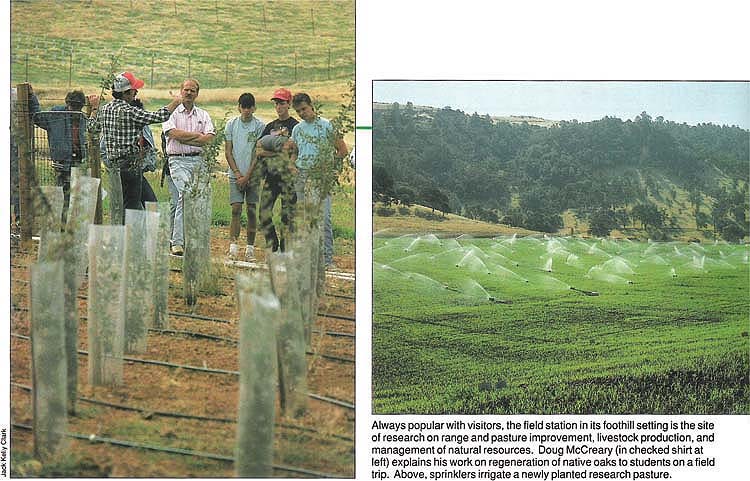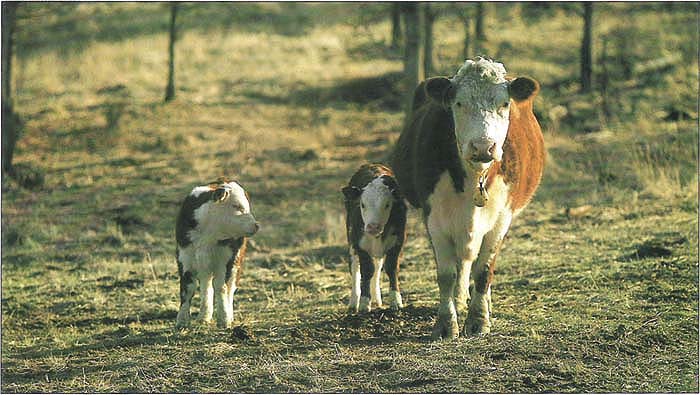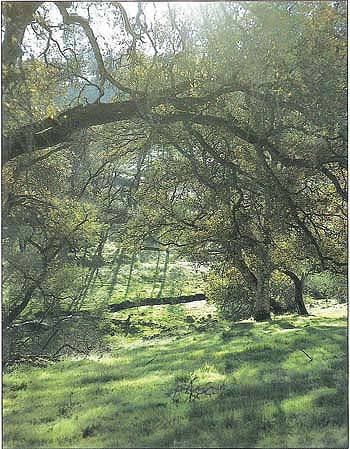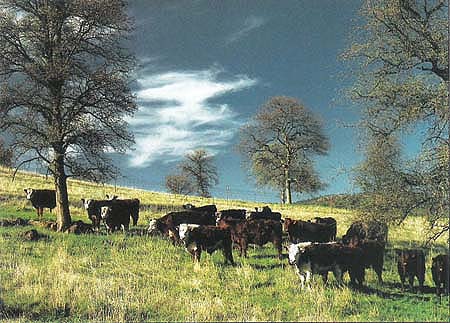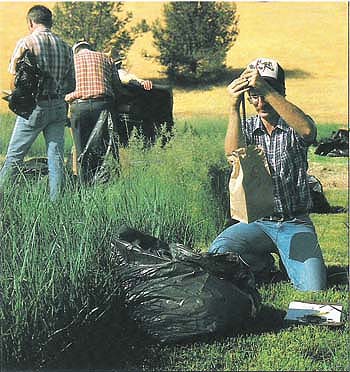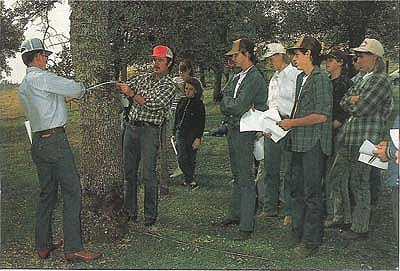All Issues
Sierra Foothill Range Field Station
Publication Information
California Agriculture 44(2):4-7.
Published March 01, 1990
PDF | Citation | Permissions
Abstract
The Sierra station, near Browns Valley in northern California, will be 30 years old this June:As can be seen from the air, the station's terrain is typical of much of California's foothill rangelands. Wooded, partially wooded, and cleared hills surround the headquarters and slope down to the Timbuctoo Bend of the Yuba River. The following eight reports indicate the variety of subjects covered by the research program at this center. (Cover photo by Charles Raguse)
Full text
Always popular with visitors, the field station in its foothill setting is the site of research on range and pasture improvement, livestock production, and management of natural resources. Doug McCreary (in checked shirt at left) explains his work on regeneration of native oaks to students on a field trip. Above, sprinklers irrigate a newly planted research pasture.
Much of the research on beef cattle at the Sierra Foothill center focuses on management of cow-calf operations. This cow and her twin calves were part of a study of the use of the embryo transfer technique to increase twinning as a possible means of improving production efficiency.
The Sierra Foothill Range Field Station, the youngest in a statewide network of nine University of California field stations and research centers, is approaching its 30th birthday. Operated by the UC Division of Agriculture and Natural Resources, the station was established June 1, 1960, when the University acquired two large parcels of land near Browns Valley in Yuba County.
The station soon became an important field laboratory for research to support livestock and agronomic productivity of foothill rangelands. Over the years, new research dimensionsNdashmanagement of open spaces, watersheds, hardwoods, and wildlifeNdashhave been added to accommodate increasing public concern about management of renewable natural resources.
The station's 5,700 acres range in elevation from less than 300 feet along the scenic Yuba River to nearly 2,000 feet in steep, woodlandbrush foothills. The climate, soils, rough terrain, and variety of vegetation types are representative of several million acres of California foothill rangelands.
This report gives an overview of the research program at the station over the last 30 years and complements the following eight companion articles, which discuss current research projects. Additional information about the research and other programs is available from John M. (Mike) Connor, Station Superintendent, Sierra Foothill Range Field Station, P.O. Box 28, Browns Valley, California 95918. Telephone: (916) 639-2501.
Range and pasture development
Range improvement at the station began with chemical treatment of blue oaks, and several major land parcels were control-burned within a few years. Reseeding, with and without phosphorus and sulfur fertilization, and chemical control of stump sprouts followed the burning. Later, vegetation-type conversions combined harvesting trees for wood, brush piling, and stump resprout control. Water delivery systems for irrigated pastures were improved.
The first agronomic research focused on the adaptation of subterranean and rose clover varieties and an inventory of resident herbaceous vegetation.
Difficulties encountered in attempting to introduce new plants into such a highly disturbed and dynamic ecosystem resulted in at least a decade of research devoted to stand establishment. Chemicals were used to suppress stump sprouting, suppress competition of resident species against those of newly introduced species, and suppress or eliminate aggressive populations of weedy species that thrived in these highly disturbed and open areas.
Chemical sprays were combined with seeding equipment designed for operation on rough land. A highly successful technique involved applying a 12-inch band of contact herbicide on germinated and growing resident vegetation while a series of rolling discs and coulters placed seed and fertilizer in mineral soil beneath new growth and plant litter from the previous year. This technique was refined when research showed that spraying a band of activated carbon directly over the planted seed reduced the effect of the herbicide on seedling growth.
Several range and pasture improvement studies looked at the influence of ecological factors on rangeland productivity. In 1963 a series of fenced plots containing new plant introductions and several fertilizer treatments were installed to sample the effect of slope, soil type, and elevation on plant growth. A more sophisticated study using small sensors to determine the influence of slope direction on sunlight received, temperature, and soil moisture found that light is the most important determinant of plant growth differences between north-and south-facing slopes. Two other studies measured condensation of transpirational water by shrub species and seasonal variations in the rate of soil weathering.
On cleared foothill rangelands, dried cow manure can be very slow to decompose, preventing grass from growing over the area it covers. Attempts to introduce Australian dung-burying beetles to break down the dried manure and, at the same time improve soil fertility by burying the manure, were not effective. The beetles were not able to adapt and become established in large enough numbers to have an impact.
Erratic results in a study of rate and time of application of phosphorus and sulfur on clover yield led to additional soil sampling that identified nematode infestation as a contributing factor.
Other rangeland fertilization studies have shown that phosphorus and sulfur are needed if introduced legumes are to do well. These findings were verified by a 3-year, whole-field grazing experiment concluded in 1985.
With terrain and climate representative of the northern California foothills, the station provides excellent conditions for studies of native oak woodlands, watersheds, and wildlife.
Studies of beef cattle on oak woodland range are concerned with a variety of problems related to herd management, nutrition, and health.
Warm-season perennial grasses are being evaluated in small plots for use in foothill irrigated pastures. At harvest, Placer-Nevada County Farm Advisor Roger Ingram weighs samples to determine production weights.
Studies on seed reserves of range forage species done between 1974 and 1977 include effects of 2 years of drought and an unusual midsummer rain. The drought reduced seed reserves drastically but did not change species composition. Few germinable seeds were carried over from year to year, and only a few species (soft chess, filaree, and rose and sub clovers) showed an ability to germinate during the hot summer.
Control of weedy species in recent years has focused on starthistle and Medusahead. Both have virtually no forage value and compete with beneficial plants. Proper timing of close grazing shows some promise for managing these species.
The management option of applying water to winter annual pastures (rangeland) in late summer or early fall was assessed in a small-plot experiment. Irrigation could produce 0.5 to 1 ton of additional high-quality forage per acre for fall and winter use by livestock without reducing spring growth potential.
In addition to range improvement studies with the important annual legumes, subterranean and rose clovers, attention was given to annual medics, especially after it became apparent that the indigenous burr clover was being eliminated by infestations of the alfalfa weevil. Annual lupines, hardinggrass, and orchard-grass also were studied. Results suggest that a combination of sub and rose clovers was better suited to the wide range of foothill environmental and management conditions than most other species, including the summer-dormant perennial grasses.
More recent evaluations of warm-season perennial grasses, including many Great Plains and Desert Southwest species never before tested under California foothill conditions, produced dry matter yields of up to 4.5 tons per acre on clipped plots in summer irrigated pastures. A companion study showed that several cultivars of bermudagrass and limpograss were more palatable to cattle than the other introductions, but none approached the acceptability of orchardgrass and dallisgrass, generally considered to be an invasive, weedy species.
A long-term study comparing results of blue oak tree removal on forage production indicated increased forage production from tree removal in all but 3 of the first 15 years of the study. Beyond 17 years, however, there was no increase in forage production. After 21 years of data collection, researchers concluded that results were influenced by weather-year differences, especially amount and distribution of precipitation; the number of trees per unit area; canopy extent and density; release of nutrients from decomposing litter and tree roots following tree treatment and removal; and nutrient redistribution resulting from livestock congregating under trees. Regeneration of oak sprouts from untreated stumps replaced much of the original cover, but there was complete absence of regeneration from acorns over the full 23-year study period.
Livestock health and management
Range experiments with beef cattle have focused primarily on management problems associated with year-round cow-calf operations in the Sierra foothills. The first livestock project compared the performance and carcass traits of crossbred Hereford, Angus, and Shorthorn calves with calves of their respective parental breeds. The results helped establish the now common practice of crossbreeding to take advantage of hybrid vigor, mothering ability, and special economic advantages of new breeds.
Evaluation of spring and fall calving supports a fall calving system for the Sierra foothills. Research on early weaning of calves showed that the advantages of early weaning (less supplement for the cows and earlier rebreeding) were overshadowed by the disadvantages (increased labor and more disease problems among the calves).
Other research highlighted stress-related breeding problems in range herds, especially when artificial insemination is used. Twice daily observations for estrus detection and the training of observers were emphasized as critical for a successful breeding program. Studies also have clearly shown the advantages of libido tests (servicing capacity) and annual examinations of bulls by a veterinarian before the breeding season.
Studies of year-round cow-calf production with and without seasonal irrigated pasture to supplement the cows' diets showed that irrigated pasture can be used where available, but returns to investment are low. Fertilizing rangeland with nitrogen, phosphorus-sulfur, or nitrogen-phosphorus-sulfur significantly increased forage production and steer liveweight gains per acre and per head.
A major concern with cow-calf enterprises in the foothills is light weaning weight of the calves, especially when heifer calves are kept for replacements and bred to calve as 2-year-olds. Grazing management studies indicated that, although irrigated pasture provides a good growing diet, energy-protein supplementation will economically increase average daily gain over energy supplementation only. Adding monensin sodium to the supplement and using growth-promoting implants at weaning are also recommended.
Epizootic bovine abortion (EBA) studies showed that the abortions result from a disease agent transmitted by the Pajaroello tick. Further research revealed that (1) cows are most susceptible to EBA when they are bitten by the tick during the third to sixth month of pregnancy, and (2) immunity is acquired when non-pregnant 2-year-old heifers are exposed to the tick. Changing from spring to fall calving in northern areas and calving in September rather than November in warmer areas of California also are effective management practices to prevent exposure to the tick during the critical stages of pregnancy.
Station Superintendent Mike Connor and Extension Natural Resources Specialist Doug McCreary measure tree diameter in a demonstration of stand evaluation techniques to a group of students.
Early studies showed that supplementing range cows with nutrients in which the forage is deficient and that are limiting for animal production can increase calf gains and may enhance rebreeding. Recent supplementation studies with protein and energy, however, produced significant responses only for rebreeding of first-calf heifers. Because of the economics involved, supplemental feeding of calves (creep-feeding) on nonsupplemented cows is the only practice that can be recommended from these experiments.
Research on internal parasites has examined seasonal patterns of buildup in beef cattle grazing foothill pastures and the response of the immune system to internal parasite loads. Guidelines were developed for more precise scheduling of available treatment preparations, and coordination of treatment with seasonal changes in pasture use.
Studies also have been done on ear tags for face fly control, selenium supplementation, pinkeye control, energy expenditure by beef steers grazing annual grassland, the development of a method to measure individual cow consumption of supplements, and electronic recording of range cow grazing and rumination behavior.
Trials continue in the areas of cow-calf management, herd health, nutrition, and grazing management.
Natural resource management
During the last decade, station research has diversified, and wildlife, forestry, soils, and watershed management form an important component of current activities.
An extensive wildlife monitoring project during the last 3 years has provided information about species abundance and use and how population levels change from season to season. Such information is vital to understanding current wildlife resources, and it can also be used to help predict how certain vegetation management practices or events (tree or brush removal, fire, or seeding of legumes) will affect wildlife populations in the future. Other wildlife projects have had a more specific focus. For instance, several have examined California quail, including one evaluating social behavior, organization, and reproductive success. Another is examining the effects of brush pile size and loft on use by quail.
The problem of poor oak regeneration is being studied extensively. Some projects are examining factors responsible for poor natural regeneration. Others are evaluating techniques for successfully growing and planting acorns and seedlings. Information from these studies has clarified some of the principal obstacles to successful seedling establishment. It has also provided practical guidelines for artificially regenerating native oaks.
Non-native hardwoods, including eucalyptus and hybrid poplar, are being studied to determine their growth rates and sensitivity to cold. Results will help determine the feasibility of biomass production in the foothills.
Since a third of California consists of rangelands, range management practices can potentially have a large impact on water yield and quality. Research in this area has focused on the effects of rangeland vegetation management on nutrients released to streams, erosion, and changes in water yield. A current study is examining nutrient dynamics among plants, water, and soils in intensively managed hardwood rangelands.
Teaching and public service
The station's teaching activities divide into three categories: class visits and tours; student internships; and student research.
Student interns from northern California colleges and universities, usually partially supported by local or state beef cattle associations, spend a school semester or quarter in residence at the station. They gain practical experience by assisting in cattle management as well as performing field work and data management tasks for various range and livestock research projects.
Results of station research are extended to growers, producers, and the general public through field days, meetings, tours, and onsite visits. The station has provided resources for training farm advisors and professionals from other universities and agencies. It also is popular with foreign visitors.
Conclusions and a forward look
For the last 30 years, the Sierra Foothill Range Field Station has been an invaluable outdoor laboratory, classroom, and demonstration facility. Research findings have traveled around the world, frequently through the wide distribution of California Agriculture. The station will continue to serve society as research, teaching, and outreach evolve in response to changes in the broad geographical area it represents.
Major contributions can be made to environmental quality through studies of multiple-use management of hardwood rangelands and oak woodlands, water use and quality relationships, and restoration ecology. Current concepts of stability and sustainability in Central Valley cropping systems also have applications in rangeland and pasture production and management.
Long-term research programs with multiple disciplines and objectives, patterned after the National Science Foundation concept of long-term ecological research (LTER), can dramatically expand the value and application of individual studies. Available communications technology and the network of Cooperative Extension advisors, together with representatives of other state and federal agencies, can make the rapid transfer of information to and from the public a reality.
The station, as part of the UC agricultural field station system, thus is well positioned to meet the challenges of the years ahead.



